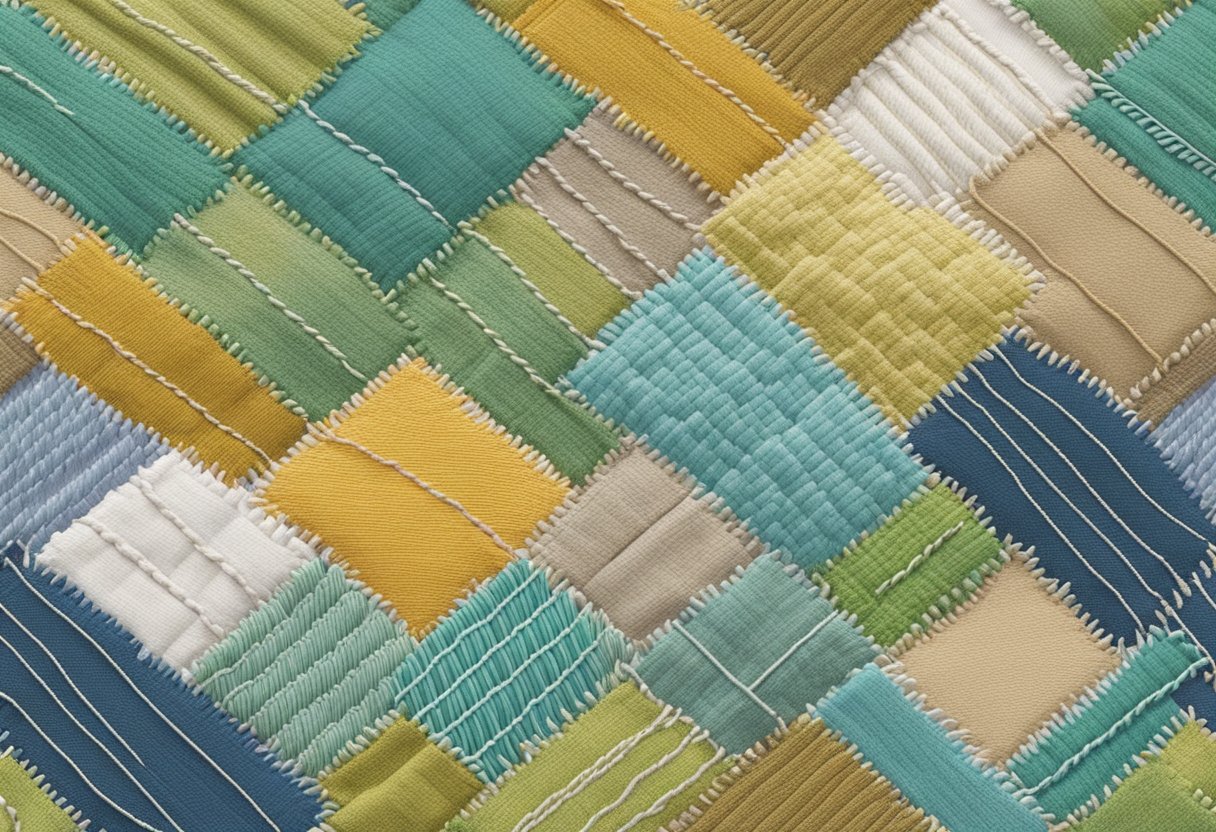Types Of Stitches
Stitching is an essential skill for anyone who wants to sew. Whether you’re a beginner or an experienced sewer, understanding the different types of stitches is crucial to achieving professional-looking results. There are many different types of stitches, each with its own unique characteristics and uses. From basic stitches to advanced techniques, stitching is a versatile skill that can be used in a wide range of sewing projects.
To get started with stitching, it’s important to understand the fundamentals of sewing. This includes learning about different types of fabrics, needles, and threads. Once you have a good understanding of these basics, you can begin to explore the different types of stitches. Hand sewing techniques are a great place to start, as they are simple and easy to learn. Some common hand stitches include running stitch, backstitch, and whip stitch.
Machine stitching mastery is another important skill to develop. Sewing machines can be used to create a wide range of stitches, from basic straight stitches to more complex decorative stitches. With practice, you can learn to control the tension, stitch length, and other settings on your machine to achieve the perfect stitch for your project.
Key Takeaways
- Understanding the fundamentals of sewing is crucial to mastering stitching.
- Hand sewing techniques are simple and easy to learn.
- Machine stitching mastery allows for a wide range of stitches and control over tension and stitch length.
Fundamentals of Stitching

Understanding Basic Stitches
Before delving into the different types of stitches, it’s important to understand the basics of stitching. A stitch is a loop of thread that passes through fabric, creating a bond between two pieces of material. The needle is used to create the stitch, and the thread is what holds the fabric together.
There are two main types of stitching: hand sewing and machine sewing. Hand sewing involves using a needle and thread to create stitches by hand, while machine sewing is done using a sewing machine.
Basic stitches include the straight stitch, zigzag stitch, overlock stitch, and buttonhole stitch. Straight stitches are the most basic type of stitch and are used for simple sewing projects. Zigzag stitches are used to finish raw edges and prevent fraying. Overlock stitches are used to finish seams and prevent fraying. Buttonhole stitches are used to create buttonholes on garments.
Tools and Materials
To start stitching, you’ll need a few basic tools and materials. These include a needle, thread, fabric, and scissors. Needles come in different sizes and are chosen based on the weight of the fabric being used. Thicker fabrics require larger needles, while thinner fabrics require smaller needles.
Thread is also chosen based on the weight of the fabric being used. Thicker fabrics require thicker thread, while thinner fabrics require thinner thread. It’s important to choose a thread that matches the color of the fabric being used to create a seamless look.
In addition to needles and thread, a pair of scissors is necessary to cut the fabric to size. It’s important to use sharp scissors to ensure clean cuts and prevent fraying.
Overall, understanding basic stitches and having the necessary tools and materials is essential for any sewing project, whether it’s done by hand or by machine.
Hand Sewing Techniques
Essential Hand Stitches
Hand sewing is a valuable skill that can be used for a variety of projects, from basic repairs to intricate embroidery. There are several essential hand stitches that every beginner should learn. The running stitch is a simple stitch that is used to sew two pieces of fabric together. It is also known as a basting stitch and is often used as a temporary stitch. The backstitch is a stronger stitch that is used to sew seams together. It is also used for repairs and embroidery.
The straight stitch is a basic stitch that is used for both sewing and embroidery. It is a simple stitch that is used to create lines, shapes, and patterns. The slip stitch is a hidden stitch that is used to join two pieces of fabric together without the stitches being visible. It is often used for hems and other types of finishing.
Advanced Embroidery Techniques
Embroidery is a decorative stitch that can be used to add texture and interest to a variety of projects. There are several advanced embroidery techniques that can be used to create intricate designs. The buttonhole stitch is a decorative stitch that is used to create a secure edge on fabric. It is often used for buttonholes and other types of closures.
The cross stitch is a popular embroidery stitch that is used to create intricate patterns and designs. It involves making small X-shaped stitches on the fabric. The whip stitch is a decorative stitch that is used to join two pieces of fabric together. It is often used for finishing seams and creating decorative edges.
The herringbone stitch is a decorative stitch that is used to create a zigzag pattern on fabric. It is often used for decorative borders and edging. The satin stitch is a decorative stitch that is used to fill in large areas of fabric with a smooth, satin-like finish. It is often used for embroidery and needlework.
In conclusion, learning hand sewing techniques and mastering different types of stitches can be a valuable skill for anyone interested in sewing, embroidery, or needlework. By mastering these techniques, you can create beautiful, professional-looking projects that will last for years to come.
Machine Stitching Mastery
When it comes to machine stitching, it’s important to master the most common machine stitches as well as decorative machine stitching. This will allow for a wide range of projects to be completed with ease and precision.
Common Machine Stitches
The most common machine stitches include the straight stitch, zigzag stitch, overlock stitch, and blind hem stitch. The straight stitch is the most basic and commonly used stitch for sewing seams and hems. The zigzag stitch is used to prevent fabric from fraying and to add stretch to seams. The overlock stitch is used to finish raw edges and prevent fraying. The blind hem stitch is used to create a nearly invisible hem on pants, skirts, and dresses.
Decorative Machine Stitching
Decorative machine stitching can add a unique touch to any project. Zigzag stitches can be used to create a decorative edge on fabric, while triple straight stitch can add a decorative touch to seams. Lock stitch is another decorative stitch that can be used to create a strong and durable seam.
It’s important to experiment with different machine stitches to see what works best for each project. Different fabrics and projects may require different stitches, so it’s important to have a good understanding of the available options. By mastering both common and decorative machine stitching, anyone can take their sewing projects to the next level.
Stitch Applications
Sewing is an art that requires a lot of skill to master, and one of the most important aspects of sewing is the choice of stitch. Different types of stitches are suitable for different fabrics, projects, and designs. In this section, we will explore the various stitch applications that can be used for different fabrics and projects.
Stitches for Different Fabrics
When it comes to choosing the right stitch for a particular fabric, it is important to consider the weight and texture of the fabric. For example, thick fabrics such as denim require a strong stitch that can withstand the weight of the fabric. The chain stitch is a good option for thick fabrics as it is strong and durable. On the other hand, lightweight fabrics such as silk require a delicate stitch that will not damage the fabric. The ladder stitch is a good option for lightweight fabrics as it is invisible and does not leave any visible stitches on the fabric.
Stitches for Specific Projects
Different sewing projects require different types of stitches. For example, hems require a stitch that will hold the fabric in place and prevent it from fraying. The topstitch is a good option for hems as it is strong and can be used to create a decorative effect. Basting is another stitch that is commonly used for sewing projects as it is a temporary stitch that can be easily removed once the project is complete.
Embroidery stitches are used for decorative stitching and can be used to add texture and style to a project. The applique stitch is a good option for adding decorative elements to a project, while the quilting stitch is a good option for creating a quilted effect. Seaming stitches are used to join two pieces of fabric together, and the backstitch is a good option for this as it is strong and durable.
In conclusion, choosing the right stitch for a particular project is crucial for achieving a professional and polished finish. By considering the weight and texture of the fabric, as well as the specific requirements of the project, you can select the perfect stitch for your needs.
Advanced Stitching Techniques
Complex Stitches for Elaborate Designs
For those who want to take their stitching to the next level, there are a variety of complex stitches that can be used to create elaborate designs. One such stitch is the catch stitch, which is often used in hemming and is known for its flexibility. Another complex stitch is the blanket stitch, which is often used in embroidery and is known for its ability to create a decorative edge. The overcast stitch is also a popular choice for finishing edges, as it can prevent fraying and add a decorative touch.
When it comes to embroidery, there are a variety of complex stitches that can be used to create intricate designs. The lazy daisy stitch is a popular choice for creating flower petals, while the herringbone stitch can be used to create a variety of geometric shapes. The fly stitch is another popular choice for creating decorative designs, as it can be used to create a variety of shapes and textures.
Troubleshooting Common Stitching Issues
Even the most experienced stitcher can run into issues from time to time. One common issue is skipped stitches, which can be caused by a variety of factors, including using the wrong needle or thread tension that is too tight. Another common issue is puckering, which can be caused by using the wrong type of fabric or not properly securing the fabric before stitching.
To avoid these common stitching issues, it is important to use the right tools and techniques. This includes using the right needle and thread for the fabric you are working with, as well as properly securing the fabric before stitching. It is also important to use the right tension on your machine, as too tight or too loose tension can cause a variety of issues.
In addition to these common issues, there are a variety of other issues that can arise while stitching. These can include knots in the thread, uneven stitches, and thread breakage. To troubleshoot these issues, it is important to carefully examine your stitching and identify the root cause of the problem. With the right tools and techniques, however, even the most complex stitching projects can be completed with ease.






